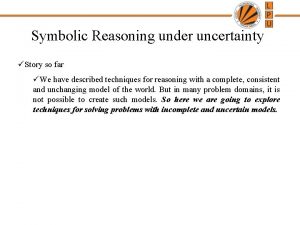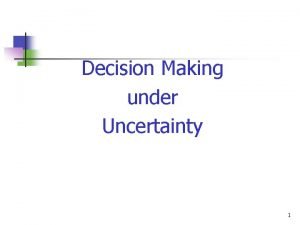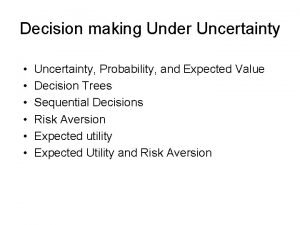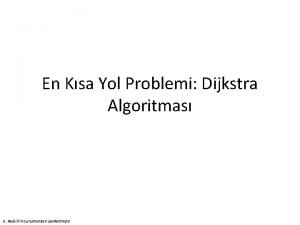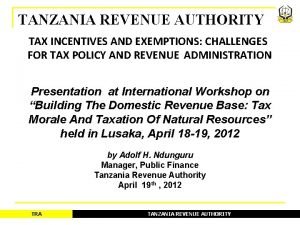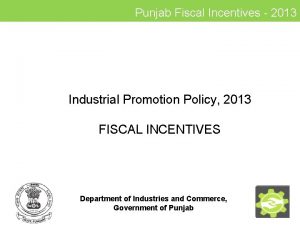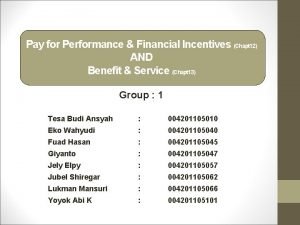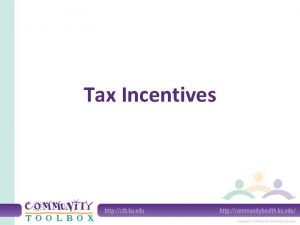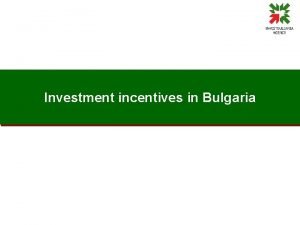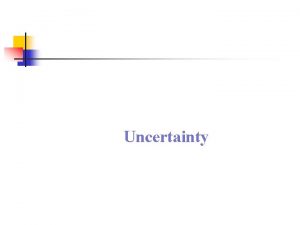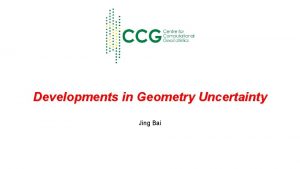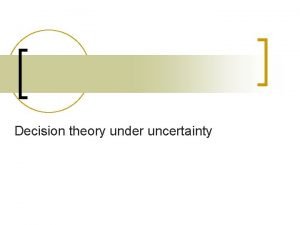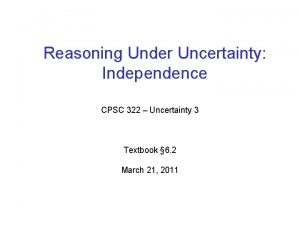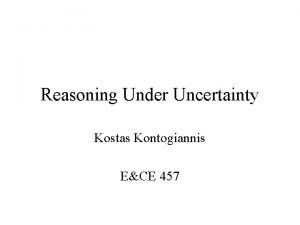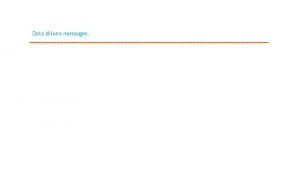Contract Incentives Under Uncertainty Data Driven Contract Geometry



















- Slides: 19

Contract Incentives Under Uncertainty Data Driven Contract Geometry Best Practices

Meet the Presenter Peter Braxton Senior Cost Analyst 2

Contracts Risk Framework, Part 1 “Filtered” by contract geometry } Take advantage of Contracts Database (KDB) as a rich data source within CADE On-shareline } Contract geometry requires backfill effort } Establish an analytical framework for Contracts Risk that takes into account incentive structures (Contract Geometry) Contract cost } Government perspective (Price) as well as Contractor perspective (ROS) } Analyzing historical growth as well as projecting future risk and uncertainty Off-shareline Contracts Database (KDB) } Apply data mining techniques to KDB to discern when different contract types and geometries were being applied appropriately (or inappropriately) Non-Contract cost } Challenge to relate to quantitative (CGF) or anecdotal (SME) measures of contract success Program Risk (SAR) 5/24/2021 3

The Role of Contract Incentives } Better Buying Power (BBP) and Incentives } Basic principle: Encourage and reinforce desired behaviors } The “pressure” of losing work leads to more prudent management, more dedicated staffing, and efforts to contain costs } Types of incentives: Cost, Performance, Schedule } Incentive Contracting Basics } } } Incentive contract types: Fixed Price Incentive (FPI) with both Firm and Successive targets Cost Plus Incentive Fee (CPIF) Cost Plus Award Fee (CPAF) Share ratios for FPI and CPIF establish cost risk ratio between Government and Contractor } Cost overrun (above the shareline) results in price increase for Government and profit decrease for Contractor according to established share ratio } Cost underrun (below the shareline) results in price decrease for Government and profit increase for Contractor according to established share ratio 4

Contract Incentives Considerations } “Contract Type” is a misnomer } Actually applies at the Contract Line Item Number (CLIN) level } Common for a contract (or delivery order) to have multiple CLINs across multiple contract types } “Incentive-Type Contracts” is a misnomer } All contract types provide an incentive to control costs } It’s just a matter of degree and timing (incremental change) } Utilizing the Full Spectrum of Contract Incentives } When is it appropriate to use each contract type? } How we can most effectively establish the contract geometry for each? 5

Differences in Cost and Risk Analysis and Contract Management Profit/Fee in Cost Analysis o Typical approach for cost analysts is to estimate “at cost” and tack on a fee o The problem: improperly models percentage fee or profit as invariant with cost in typical risk analyses o Contract geometry would be incorporated where known (or reasonably estimated) for major contracts o Cost risk and uncertainty are run through the “filter” of contract geometry to determine the resultant distribution of both Price and Margin o To further refine, we’d want to model the separation of onshareline and off-shareline growth Profit/Fee in Historical Cost Growth Analysis Profit/Fee in Contract Management 6

Differences in Cost and Risk Analysis and Contract Management Profit/Fee in Cost Analysis Profit/Fee in Historical Cost Growth Analysis o Where do the cost risk distributions come from in the first place? -Historical cost growth analysis o Contract geometry often produces counterintuitive distributions (Price, Margin) Profit/Fee in Contract Management 7

Differences in Cost and Risk Analysis and Contract Management Profit/Fee in Cost Analysis Profit/Fee in Historical Cost Growth Analysis Profit/Fee in Contract Management o The Profit/Fee are subject of negotiations and the application of “weighted guidelines” o Focus: avoid excessive profit o Ideally, the reconciliation of cost risk analysis and negotiation of contract geometry would occur in conjunction with each other and not in isolation o The Government is coming to a realization that there is an inherent trade-off for the corporations between target fee and risk position of the bid 8

Contracts Database (KDB) as a Resource } KDB Current Status o Over the years, KDB thought leadership and sponsorship has come from multiple sources: • Air Force Cost Analysis Agency (AFCAA) • Marine Corps Program Executive Office Land Systems (PEO LS) • Office of the Deputy Assistant Secretary of the Army for Cost and Economics (ODASA-CE) • Naval Center for Cost Analysis (NCCA) o Currently, KDB is under the aegis of Cost Assessment Data Enterprise (CADE) • Further ensures alignment with broader cost community data needs } KDB Scope o KDB provides CLIN-level price, quantity, and schedule data o All changes tracked by individual modifications o Backfill effort to break out price into cost and fee, where possible (CPFF, CPAF, CPIF, FPIF) o Total contract value in KDB exceeds half a trillion dollars o Initial focus was Missiles and Munitions o Many other commodities have since been added: Aircraft, Electronics, Wheeled and Tracked Vehicles, AIS, etc. 9

Price Growth Categories vis-à-vis the Shareline } CLIN-level Cost, Fee, and Price data enable Profitability Analysis o Profitability analysis within CADE is a key area for data fusion between KDB and Contractor Cost Data Reports (CCDRs) o Table below shows classification of mods to attribute price changes to one of the Growth Categories o In theory, Cost and Schedule mods should constitute on-shareline growth whereas Baseline and Technical mods would constitute off-shareline growth Price Growth Categories Baseline for all modifications where anticipated changes impact the contract value. Cost for all modification where unanticipated price changes with no change in scope impact the contract value Technical for all modifications where unanticipated scope changes impact the contract value Schedule for all modifications where unanticipated schedule changes impact the contract value Administrative for all modifications that do not change the overall contract price 10

Prevalence of Major Contract Types } Benchmarks for Contract Type o FFP an order of magnitude more prevalent than CPFF o CPFF in turn an order of magnitude more prevalent than Incentive-type } Benchmarks for Contract Geometry Parameters o Need to backfill and mine KDB at the CLIN level to obtain useful data for characterizing contract geometry parameters o Such parameters include: target fee percent; ceiling price percent; share ratios (over and under); min and max fee (percentages); and base fee and award fee (percentages) o Desired computations: initial and final margin percentage (or equivalently Return of Cost) for all CLINs, would show the impact of mods on profitability over time Contract Types in KDB Contract Type Count Value By Count By Value Average Size CPAF 632 $ 51, 012, 918, 376. 09 1. 1% 12. 9% $80, 716, 643. 00 CPIF 665 $ 24, 081, 165, 007. 56 1. 2% 6. 1% $36, 212, 278. 21 FPIF 1, 296 $ 70, 482, 041, 186. 76 2. 3% 17. 8% $54, 384, 291. 04 FFP 40, 446 $ 167, 832, 774, 252. 10 71. 5% 42. 4% $4, 149, 551. 85 COST & CPFF 6, 949 $ 29, 755, 157, 311. 01 12. 3% 7. 5% $4, 281, 933. 70 Other 6, 559 $ 52, 434, 424, 590. 58 11. 6% 13. 3% $7, 994, 271. 17 Total 56, 547 $ 395, 598, 480, 724. 10 100. 0% $6, 995, 923. 40 11

Contracts Database (KDB) as a Resource } 12

Contracts Database (KDB) as a Resource Contract Texture Clusters by Phase 13

Contracts Database (KDB) as a Resource Contract Texture Clusters by Service 14

Historical Cost Growth Analysis and Contract Risk Modeling } On-Shareline Cost Growth and Implications for Price and Margin o Looking at the “Big Four” contract types (FFP, FPI, CPIF, and CPFF) o FFP is essentially a 0/100 share ratio (the Contractor bearing all the cost risk) o CPFF is essentially a 100/0 share ratio (the Government bearing all the cost risk) o “On-shareline” occurs on one or more existing CLINs, and the contract modification will change the projected final cost without changing the contract geometry o This causes revisions in both the price to the government and the contractor’s margin, as the cost change “runs up” the shareline (overrun) } Off-Shareline Cost Growth and Implications for Price and Margin o This occurs when “new work” is added to some combination of existing and new CLINs in a “profit-neutral” manner o The contract geometry is then modified to add both cost and fee in the same proportion as in the original CLIN(s) o The impact of off-shareline growth is illustrated by adding $1 M in additional work to our example FPIF contract at the same 10% target fee 15

Assessing Contract Types and Contract Geometry } Historical Cost Growth by Contract Type o KDB has an associated Visual Analysis Tool (VAT) that allows us to aggregate historical cost growth metrics by: • Contract, • Program, • Contractor, etc. o We can also use the KDB Pivot Tool to generate historical cost growth by contract type } Ecclesiastes: To Every Contract Type, There Is a Season o The greater risk is applying an inappropriate contract type to a given program phase and scope of work o Diagnosing this with greater fidelity requires a mixture of better metadata and expert judgment o We should be beware of retroactive diagnoses that rationalize what may or may not have gone better had a different course of action had been chosen o Like cost analysis, contract management is an “unrepeatable experiment” 16

Next Steps } KDB Data Collection o o To date, the population of KDB has been a manually intensive process Data collection priorities have been directed by the study sponsors over the years KDB has sporadic data for some system types (e. g. , Ships), and more robust data for others By more comprehensively populating other system types, not only do we increase the overall number of usable data points in the database, but we enable comparison between system types to determine whethere any statistically significant differences between them } KDB Automation o The automation process uses Python scripts to transfer the contents of each computer-generated PDF file (contract or modification) into a text file (. txt). o The text files are then “cleaned” and parsed for requisite information and data using R software o The “cleaned” data is populated into an Excel file, which can then directly feed the master Microsoft Access database o Automation will greatly increase the speed and accuracy of data acquisition } KDB Future State o It would be even better to “cut out the middleman” of the PDF and tap directly into the data fields that were used to generate the contract o Defense Procurement and Acquisition Policy (DPAP) organization has worked with the community to develop a Procurement Data Standard (PDS) o PDS specifies the XML schema for all information needed to generate a valid contract or mod o With PDS information directly available, a repeatable mechanism to ingest the requisite data into KDB could be developed to create a more efficient data acquisition process o However, we will always need “analyst in the loop” for Mod (e. g. , Category) and CLIN (e. g. , WBS mapping) 17

Next Steps } Leveraging Data Fusion Via CADE Integration o There is a tremendous possibility in data fusion between KDB and the current contents of the CADE back-end relational database: • Cost data from CCDRs (including profit for FFP) • EVM data from Contract Performance Reports (CPRs) and Integrated Program Management Reports (IPMRs) • Budget, quantity, contract funding, and contextual major program event data integrated from the Defense Acquisition Management Information Retrieval (DAMIR) system } Revisiting and Reconciling Program and Contract Cost Growth o It should be straightforward to map KDB contracts to CSDR and EVM reporting contracts in CADE o On a program-by-program basis, and in aggregate (broken out by Service, Commodity, etc. ), we should be able to compare the latest SAR cost growth numbers with those from KDB o The hope is to yield not only analytical insights but also lesson learned for a tighter integration of cost and risk analysis and contract management functions going forward } Supplementing Contracts Data with CSDR Data o SAR data in CADE will allow us to cross check historical cost and schedule growth metrics with KDB o Cost and Software Data Reporting (CSDR) data – CCDRs in particular – present the greatest opportunity for supplementing the cost and profit/fee breakout in KDB } Refining Contract Texture Metrics and Contract Categorization o We will use a combination of automation, systematic data analysis, and targeted subject matter expert (SME) insight to try to untangle appropriate vs. inappropriate use of contract types o We can develop rubrics that can serve as guides to encourage appropriate use of contract types and contract geometries, and conversely, to provide warnings of potential inappropriate use 18

Thank You pbraxton@technomics. net | 571 -366 -1431
 Symbolic reasoning example
Symbolic reasoning example Uncertainity in decision making
Uncertainity in decision making Decision-making under uncertainty
Decision-making under uncertainty Capital budgeting under uncertainty
Capital budgeting under uncertainty Expected profit under uncertainty
Expected profit under uncertainty Consumer driven contract testing
Consumer driven contract testing Consumer-driven contract testing
Consumer-driven contract testing Theory of structures
Theory of structures 4 electron domains 2 lone pairs
4 electron domains 2 lone pairs The basis of the vsepr model of molecular bonding is
The basis of the vsepr model of molecular bonding is Ias 15
Ias 15 Contingent contract and wagering agreement
Contingent contract and wagering agreement Tax incentives in tanzania
Tax incentives in tanzania Type of sales promotion
Type of sales promotion Fiscal incentives for industrial promotion (revised)-2013
Fiscal incentives for industrial promotion (revised)-2013 Contoh pay for performance
Contoh pay for performance Work incentives network oregon
Work incentives network oregon Liberty mutual instant incentives
Liberty mutual instant incentives Emc services partner web
Emc services partner web Trade marketing plan ppt
Trade marketing plan ppt
